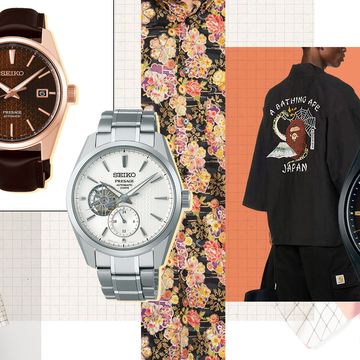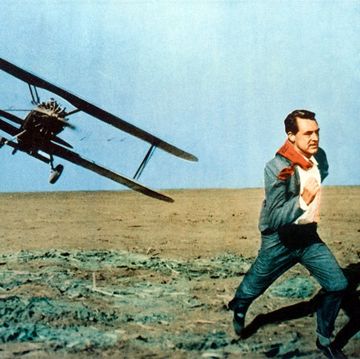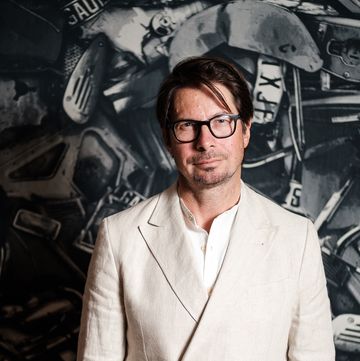On Friday morning, Rockstar Games&apos vaunted Western, Red Dead Redemption, will finally ride into town (and your weekend plans will change irrevocably). Esquire caught up with Rockstar art director, Rob Nelson, for an exclusive pre-launch Q&A...
ESQ: There have been so few memorable &aposcowboy&apos titles in the history of video games (pre Red Dead Revolver, the flawed but fun Mad Dog McCree for the Mega-CD comes to mind), and yet it&aposs a genre that has such obvious resonance with gamers. Why do you think there&aposs been so little on offer?
RN: Part of the reason is that Westerns rely heavily on being able to accurately recreate a mood and a setting - the landscape and atmosphere are major contributors to your enjoyment. For Red Dead Redemption to work as well as it does, we needed to be able to create those massive vistas and wide horizons we&aposre familiar with from a classic Western, and we needed to make that Western environment feel compelling and believable.
That&aposs where we feel games have an advantage over film at this point - we can offer much more context and atmosphere, and really allow people to inhabit the world and its characters in a way that&aposs almost impossible to do in a two-hour film - so we think now, with modern technology, we are finally able to do justice to the source material. To put it in blunt technical terms, computers are better at drawing straight lines than curves, but natural environments and old fashioned equipment is full of curves, so only the newest consoles can actually make environments that look and feel like the wilderness.
ESQ: What&aposs the biggest challenge in realising a Wild West environment in a video game?
RN: The first challenge is a technological one: it&aposs not easy to create the kind of wide open, dynamic rural landscapes a proper western requires - open world games often rely on the crutch of the many corners and breaks in the horizon that city landscapes offer. That was a challenge that we solved with the upgrades we&aposve made to the Rockstar Advanced Game Engine (RAGE) - the same engine we&aposve used now for Grand Theft Auto IV, Midnight Club Los Angeles and initially, Table Tennis.
The next challenge is to fill that space with activity and life in a believable way, and thankfully we have some experience with this through the work we&aposve put into our other games, such as Grand Theft Auto and Bully. We&aposve got an eco-system and food chain with over 60 in-game animals, all of which you can hunt and skin. So the challenge was to make exploration of the game world incredibly atmospheric and immersive, but also enjoyable from the perspective of gameplay.
More than any of our other games, the world of Red Dead Redemption is full of ambient, random events that you can opt into if you happen to come across them, like an official needing help apprehending escaped criminals that were being transported, or a woman being attacked by an unwanted suitor, or simply trying to avoid being eaten by a bear. They will vary depending on many factors, such as where you are in the world, the time of day, even what you may be wearing at the time. These give you the opportunity to dip into the world around you, coming to the aid of someone and getting a reward for your troubles. They also serve to break a journey.
Equally, if you really just want to get from A to B quickly you can ignore them and plough on or there are the stagecoaches and trains you can use as well as the ability to quick travel to any town you have visited from your campsite. The biggest challenge has been providing this whole massive world, and then packing it with a level of life and bustle that engages and immerses the player. In Red Dead Redemption you definitely get the feeling that the world exists despite you, rather than because of you.
ESQ: From first impressions, the new game has obviously drawn from a number of influential films in the Western genre, but did you have any one particular film or director in mind when you were developing Red Dead Redemption?
RN: Red Dead is a completely original story, but there have been a number of films with concepts or themes that we love that have undoubtedly influenced us. The idea of a band of misfits struggling to maintain a place for themselves in a turbulent time of change was prevalent in The Wild Bunch, and that theme also runs through Red Dead Redemption. Certainly, if we could get the action anywhere hear Peckinpah levels, we would be very happy.
Equally, the blurring of the line between the good guys and the bad is reminiscent of films like Treasure of Sierra Madre and Unforgiven. And the idea of a brutal world being forced to order at any cost in some ways echoes the Australian Western, The Proposition. The idea that at the dawn of the Twentieth century represented the end for famous outlaws and gunslingers is explored brilliantly in another couple of films we love: John Wayne&aposs last film, The Shootist, and, of course, Butch Cassidy and The Sundance Kid. That said, there&aposs 100s of other films we love and used as inspiration.
ESQ: What had you learned from making Red Dead Revolver that you wanted to update or improve upon with Redemption?
RN: We learned that taking over projects midway through presents very specific sets of issues, even for projects you love. Red Dead Revolver was a game that we inherited part made from Capcom as part of a deal to buy Angel Studios, which since became Rockstar San Diego. We saw a lot of opportunity in a western, but the original game wasn&apost a Rockstar production from the ground up. However, the idea for an open world Western game on the same scale as our other games, like Grand Theft Auto IV and Bully, was a direct result of the fun we had working on bringing Red Dead Revolver to completion.
Red Dead Revolver was an incredibly fun shooter that was a tribute to all the Wild West clichés everyone has grown up with, with an Ennio Morricone soundtrack, wacky characters and stereotypical end-of-level baddies. Working on Revolver gave us a very clear inspiration as to where we&aposd go with its successor - how we would make our next western game if we&aposd be able to do it from scratch. Revolver&aposs story is the myth of The West, while Redemption is the West more as it was, brutal , somewhat cynical and unforgiving, without the clear delineation between the good and bad guys that defined the Old West legends, with gameplay that radically expands on the first game to blend over-the-top action and shooting with exploration and character progression.
ESQ: What are you most proud of in the new game? And how do you want Redemption to be remembered?
RN: We&aposd like it to be remembered as the first game that truly did justice to the Western setting in a videogame - our aim is to do for the Western what GTA did for the idea of urban crime games. We have an epic story about John Marston, a former outlaw who&aposs sent by force to the frontier to hunt down the members of his former gang during a time of violent change in American history, and we want people to experience that story. But the world we&aposve created offers so much more: If you want to go hunt a buffalo and sell the skins in a market town you can. If you want to rescue horses from a burning barn you can. If you want to break in a wild mustang you can. If you want to lasso and hogtie a criminal and take him back to the sheriff and collect the bounty you can.
Then if you want to get drunk in the saloon afterwards and shoot the place up you can do that too - you can turn the whole settlement into a ghost town if you want, but there will be interesting consequences for almost every action you take in the game thanks. You might come across a stagecoach in the process of being robbed, and you can choose to assist the robbers or take them down and rescue the stagecoach&aposs owners, with very different opportunities for fame and rewards depending on the decisions you make. But most of all, it&aposs about the notion of freedom, both as a gameplay concept and its significance within the real story of what happened to the American West.








